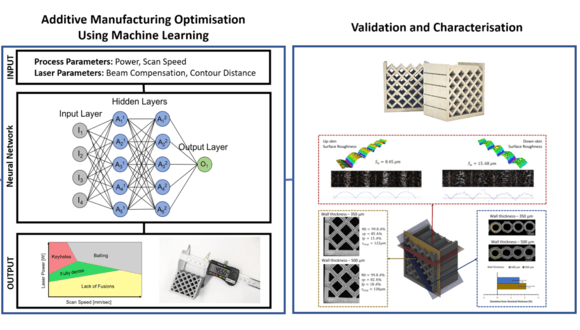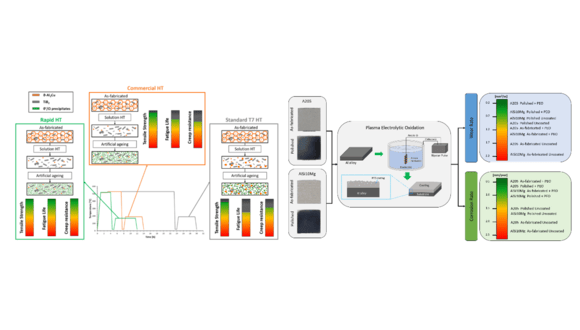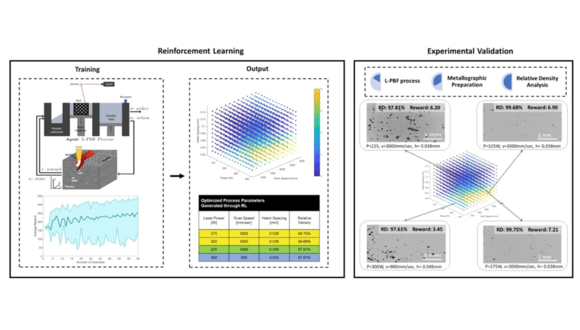Mon, 07 April, 2025

We are pleased to announce that Francesco Careri has completed his PhD with the submission of his thesis, ‘Additive Manufacturing of High-Strength Aluminium Alloys for Thermal Management Applications.’
Francesco’s studies were sponsored by NSIRC at TWI and EPSRC CDT in Topological Design at the University of Birmingham. His industrial supervisor was TWI Consultant, Dr Raja Khan and his academic supervisor was Professor Moataz Attallah from the University of Birmingham.
The PhD thesis focused on advancing Laser Powder Bed Fusion (L-PBF) technologies and optimising high-strength aluminium (Al) alloy materials for innovative thermal management solutions for the aerospace sector.
The study focused initially on optimising L-PBF process parameters for novel thin-walled structures for heat exchangers (HXs). Machine learning (ML) algorithms, such as neural networks (NN), were applied to optimise important process parameters, identifying the complex relationships between parameters and properties, and minimising time-intensive experimental campaigns. The optimised parameters enabled the successful manufacture of a novel HX design, demonstrating the feasibility of ML-driven optimisation approaches for aerospace thermal systems. Microstructural and surface quality analyses revealed enhanced accuracy and a defect-free microstructure, mitigating leakage risks and failure during operation.
 Figure 1. Optimisation of L-PBF process parameters using Machine learning for manufacturability of thin complex geometries. Computer vision and neural networks were trained using experimental data and used to predict the optimal parameters to successfully manufacture a novel complex Heat Exchanger chaarcterised by thin features.
Figure 1. Optimisation of L-PBF process parameters using Machine learning for manufacturability of thin complex geometries. Computer vision and neural networks were trained using experimental data and used to predict the optimal parameters to successfully manufacture a novel complex Heat Exchanger chaarcterised by thin features.
The research also saw the development of tailored heat treatments (HTs) of high-strength Al alloys, which is crucial for their use in additively manufactured parts for the aerospace industry. A novel HT was developed for the high-strength A205 Al alloy, and the obtained microstructure and mechanical properties were compared to the Standard T7 HT and a Commercial HT. A significant reduction in grain size of Rapid HT and Commercial HT compared to the Standard T7 HT was found. The results showed a higher presence of finer Ω-Al2Cu and ƀ'-Al2Cu precipitates for the Rapid HT than the other HTs, achieving a tensile strength of 465 MPa, compared to the Standard T7 HT (422 MPa) and Commercial HT (449 MPa). Fatigue tests at room temperature and creep tests at 180 °C further confirmed a significant improvement in performance of the newly developed Rapid HT.
 Figure 2. Influence of the newly developed HT compared with the most used HTs for the A205 alloy in terms of mechanical properties and phase transformations. Influence of PEO treatment on the corrosion and wear performance of high-strength Al alloys fabricated via L-PBF.
Figure 2. Influence of the newly developed HT compared with the most used HTs for the A205 alloy in terms of mechanical properties and phase transformations. Influence of PEO treatment on the corrosion and wear performance of high-strength Al alloys fabricated via L-PBF.
Mechanical properties were analysed using a strengthening mechanism model to link precipitate formation to observed behaviour, and a post-processing surface treatment was studied to address the requirements in tribological and corrosion performance of high-strength Al alloys, A205 and AlSi10Mg, in severe environments. In particular, plasma electrolytic oxidation (PEO), was applied to the two alloys produced using L-PBF. The PEO coatings were produced on as-received and polished surfaces. The results demonstrated significant improvements in tribological and corrosion resistance of the coated surface, particularly for pre-treatment surfaces, highlighting the importance of surface preparation for optimising performance.
Finally, an interdisciplinary study was conducted, implementing a novel ML model to optimise the L-PBF process strategy for minimising porosity. A reinforcement learning (RL) framework, incorporating thermal modelling principles, accurately identified optimal parameter combinations to reduce defects in the A205 Al alloy. This ML approach reduced reliance on extensive experimental data and simulations. Experimental validation confirmed the effectiveness of the RL approach in improving the reliability of L-PBF processes for high strength aluminium alloys.
 Figure 3. Reinforcement learning algorithm flowchart. A digital twin of the L-PBF process was generated; the algorithm predicted the influence of process parameters on the porosity based on physical equation and reward functions; finally the validation of the model was carried out with experimental results.
Figure 3. Reinforcement learning algorithm flowchart. A digital twin of the L-PBF process was generated; the algorithm predicted the influence of process parameters on the porosity based on physical equation and reward functions; finally the validation of the model was carried out with experimental results.
This research demonstrated the potential of combining advanced manufacturing, ML-driven optimisation, and tailored post-processing to enhance the performance of high-strength Al components for aerospace applications, addressing challenges in structural integrity, thermal efficiency, and durability.
We would like to congratulate Francesco on the completion of his PhD, which is testament to the support provided by TWI to progress the next generation of industry experts.